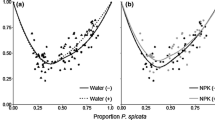Abstract
Exotic plant invasions are a serious concern for land managers and conservationists. There is evidence that increased nitrogen availability favors exotic species and decreased nitrogen availability favors non-weedy native species. This study was conducted to test the effect of nitrogen availability on competition between two grass species with contrasting life histories, cheatgrass (Bromus tectorum), a North American exotic, and blue grama (Bouteloua gracilis), a North American native. We investigated the effects of nitrogen availability and competition on aboveground biomass, belowground biomass, height, and % nitrogen tissue concentrations by growing the two species in the greenhouse under five levels of nitrogen and six levels of competition. Nitrogen availability affected competition between Bromus tectorum and Bouteloua gracilis. At the lowest level of N availability, neither species was affected by competition. As N availability increased, aboveground biomass gain of Bromus was more negatively affected by intraspecific competition relative to interspecific competition while the opposite occurred for Bouteloua. At the competition level at which each species gained the most aboveground biomass, Bromus had a linear response to increasing N availability while the response of Bouteloua was asymptotic. Our results do provide some support for the theory that fast growing exotic species have a rapid response to nutrient enrichment while native non-weedy species do not, and that low N levels can reduce competitive pressure from the exotic on the native.
Similar content being viewed by others
References
Alpert P. and Maron J.L. 2000. Carbon addition as a countermeasure against biological invasion by plants. Biological Invasions 2: 33–40.
Baker H.G. 1986. Patterns of plant invasion in North America. In: Mooney H.A. and Drake J.A. (eds), Ecology of biologically invasions of North America and Hawaii. Springer-Verlag, New York, pp. 44–57.
Burke M.J. and Grime J.P. 1996. An experimental study of plant community invasibility. Ecology 77: 776–790.
Carson W.P. and Barrett G.W. 1988. Succession in old-field plant communities: effects of contrasting types of nutrient enrichment. Ecology 69: 984–994.
Chapin F.S. 1980. The mineral nutrition of wild plants. Annual Review of Ecology and Systematics 11: 233–260.
D'Antonio C.M. and Vitousek P.M. 1992. Biological invasions by exotic grasses, the grass/fire cycle, and global change. Annual Review of Ecology and Systematics 23: 63–87.
de Wit C.T. 1960. On Competition. Verslagen van Landbouwkundige Onderzeokingen. Number 66. Centre for Agricultural Publishing and Documentation, Wageningen, The Netherlands.
Great Plains Flora Association 1986. Flora of the Great Plains. University Press of Kansas, Lawrence, Kansas, USA.
Grime J.P. 1977. Evidence for the existence of three primary strategies in plants and its relevance to ecological and evolutionary theory. American Naturalist 11: 1169–1194.
Huenneke L.F., Hamburg S.P., Koide R., Mooney H.A. and Vitousek P.M. 1990. Effects of soil resources on plant invasion and community structure in California serpentine grassland. Ecology 71: 478–491.
Huston M.A. 1994. Biological Diversity: the coexistence of species in changing landscapes. Cambridge University Press, New York.
Kotanen P.M., Bergelson J. and Hazlett D.L. 1998. Habitats of native and exotic plants in Colorado shortgrass steppe: a comparative approach. Canadian Journal of Botany 76: 664–672.
Lauenroth W.K. and Sala O.E. 1992. Long-term forage production on North American shortgrass steppe. Ecological Applications 2: 741–749.
Lowe P.N., Lauenroth W.K. and Burke I.C. 2002. Effects of nitrogen availability on the growth of native grasses and exotic weeds. Journal of Range Management 55: 94–98.
Mack R.N. 1981. Invasion of Bromus tectorum L. into western North America. An ecological chronicle. Agroecosystems 7: 145–165.
Milchunas D.G. and Lauenroth W.K. 1995. Inertia in plant community structure:State changes after cessation of nutrient enrichment stress. Ecological Applications 5: 452–458.
Milchunas D.G., Lauenroth W.K., Chapman P.L. and Kazempour M.K. 1989. Plant communities in relation to grazing, topography, and precipitation in a semiarid grassland. Vegetatio 80: 11–23.
Morghan K.J. and Seastedt T.R. 1999. Effects of soil nitrogen reduction on nonnative plants in restored grasslands. Restoration Ecology 7: 51–55.
Muller B. and Garnier E. 1990. Components of relative growth rate and sensitivity to nitrogen availability in annual and perennial species of Bromus. Oecologia 84: 513–518.
Padgett P.E. and Allen E.B. 1999. Differential responses to nitrogen fertilization in native shrubs and exotic annuals common to Mediterranean coastal sage scrub of California. Plant Ecology 144: 93–101.
SAS Institute 1989. SAS statistics. SAS Institute, Cary, North Carolina, USA.
Vitousek P.M. 1986. Biological invasions and ecosystem properties: can species make a difference? Ecological Studies: Analysis and Synthesis 58: 163–176.
Vitousek P.M. 1990. Biological invasions and ecosystem processes: towards and integration of population biology and ecosystem studies. Oikos 57: 7–13.
Vitousek P.M., D'Antonio C.M., Loope L.L. and Westbrooks R. 1996. Biological invasions as global environmental change. American Scientist 84: 468–478.
Wedin D.A. and Tilman D. 1990. Species effects on nitrogen cycling: a test with perennial grasses. Oecologia 84: 433–441.
Wilson S.D. and Tilman D. 1991. Interactive effects of fertilization and disturbance on community structure and resource availability in an old-filed plant community. Oecologia 88: 61–71.
Wilson S.D. and Gerry A.K. 1995. Strategies for mixed-grass prairie restoration: herbicide, tilling, and nitrogen manipulation. Restoration Ecology 3: 290–298.
Zink T.A. and Allen M.F. 1998. The effects of organic amendments on the restoration of a disturbed coastal sage scrub habitat. Restoration Ecology 6: 52–58.
Author information
Authors and Affiliations
Corresponding author
Rights and permissions
About this article
Cite this article
Lowe, P.N., Lauenroth, W.K. & Burke, I.C. Effects of nitrogen availability on competition between Bromus tectorum and Bouteloua gracilis . Plant Ecology 167, 247–254 (2003). https://doi.org/10.1023/A:1023934515420
Issue Date:
DOI: https://doi.org/10.1023/A:1023934515420




